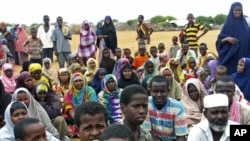As population growth, resource depletion and climate change strain the world’s food supplies, a new report highlights solutions from some unexpected places. Sub-Saharan Africa harbors most of the world’s hungriest countries. The report from the Worldwatch Institute, a Washington, DC-based environmental group, however, says the continent also is home to a wealth of ideas that can help the world fight hunger and poverty.
Here in one of the largest slums of Africa, Danielle Nierenberg, a researcher at the Worldwatch Institute, said there's something surprising and hopeful. "We've met with some great women farmers who are doing this really innovative way of growing food so they don't have to buy anything from the market."
These urban farmers in Nairobi are growing vegetables just outside their doorsteps using nothing more complicated than old sacks filled with soil. What they don't eat, they sell, and use the revenue to put their children through school.
Back in Washington, Nierenberg said it’s not what she expected from a neighborhood plagued by poverty. "It’s a slum. It’s depressing. It’s crowded. It’s dirty. It’s noisy. But these people are finding ways to make their lives better."
With half the world’s population living in and around cities, experts are increasingly looking to these kinds of ideas to feed malnourished city dwellers - not just in Africa, but around the world.
Nierenberg saw many innovations in agriculture during a year-long tour of 25 countries in sub-Saharan Africa. What she learned is at the heart of a new Worldwatch report.
"I think there are a lot of lessons that we in the Western world can learn from Africa. And what they are doing is certainly applicable to other developing countries," said Nierenberg.
In a world with nearly a billion hungry people, Nierenberg said these lessons can serve as a roadmap for global investment in agriculture. For example, in Nigeria, village processing centers are helping farmers reduce their losses and earn more income by processing cassava, a root vegetable, into staple foods.
Developing-world farmers often lose 25 to 40 percent of their harvest to improper handling, spoilage and pests, before it ever reaches the market. That aggravates hunger and pushes up prices.
The report highlights how more attention can be paid to preserving harvests.
"Given all that we invest in producing food in the first place, we need to devote the same amount of attention to making sure that it’s not wasted," said Nierenberg.
Daniel Gustafson heads the Washington, D.C., office of the United Nations Food and Agriculture Organization. He said programs for developing-world farmers are often driven by outside interests. And that, he said, brings up another point.
"How important it is for researchers and donors and governments to pay attention to farmers and what they know and what they’re trying out," said Gustafson.
With hunger and conflict dominating Western news from Africa, Nierenberg said her year-long excursion was different than she expected. "I went to Africa with very little hope in my heart, and was so surprised by everything I saw. So I do see hope in all the innovations we saw on the ground."
She said, though, that farmers in the developing world need more backing from donors and their own governments to make these innovations work.













